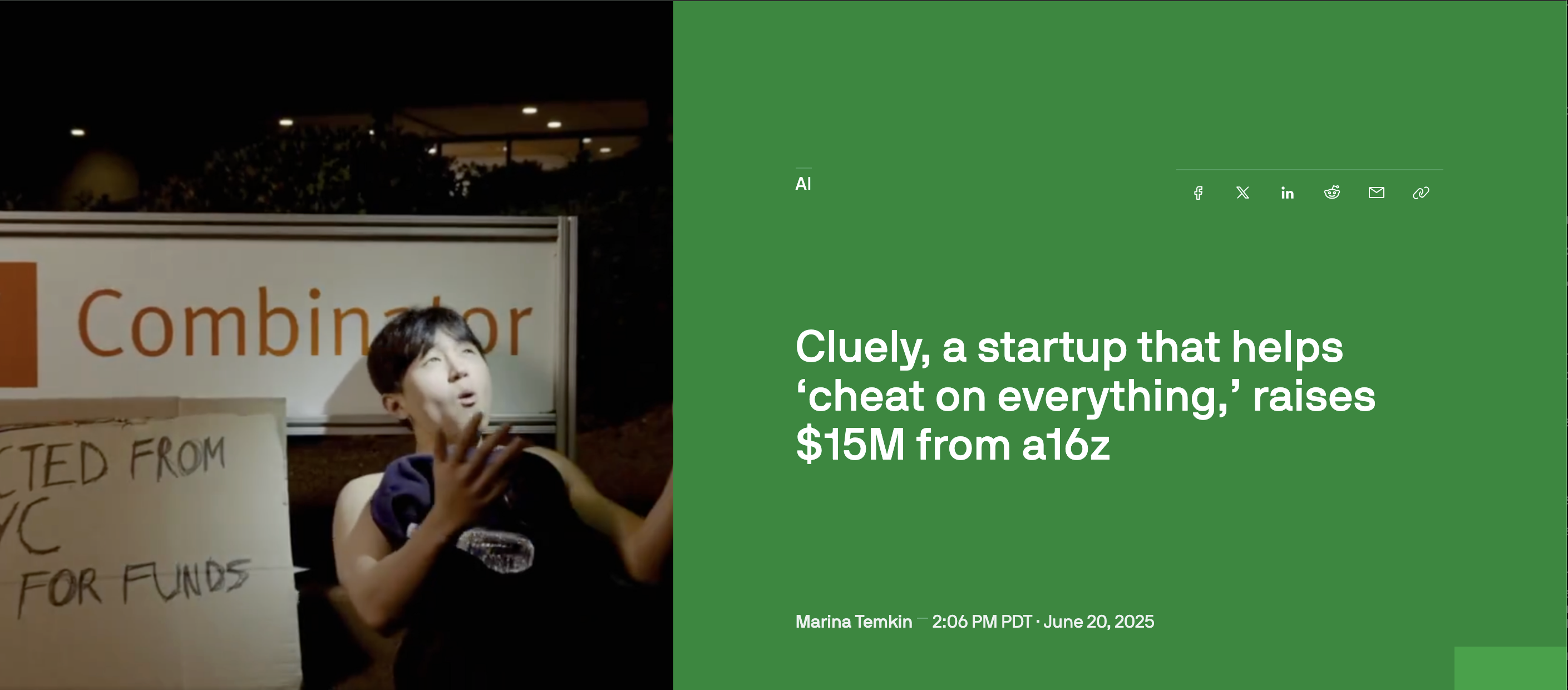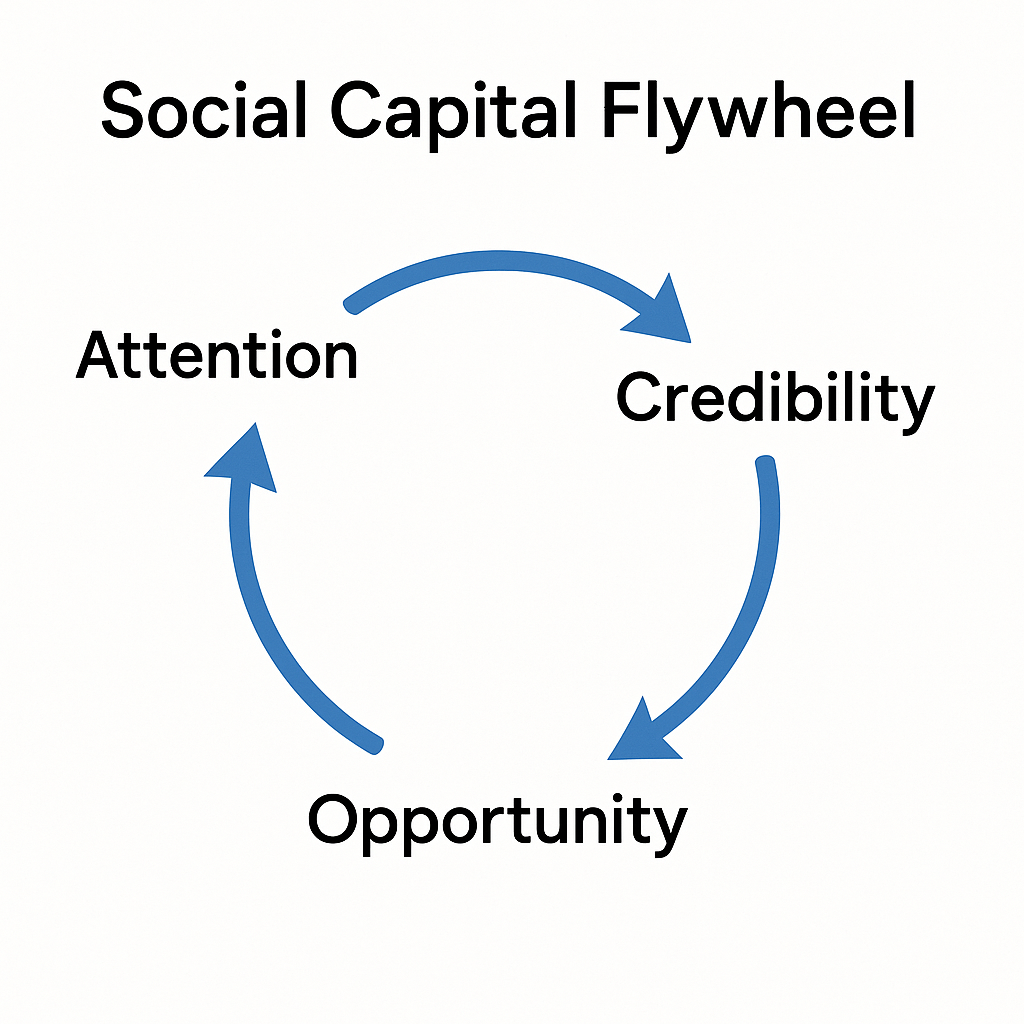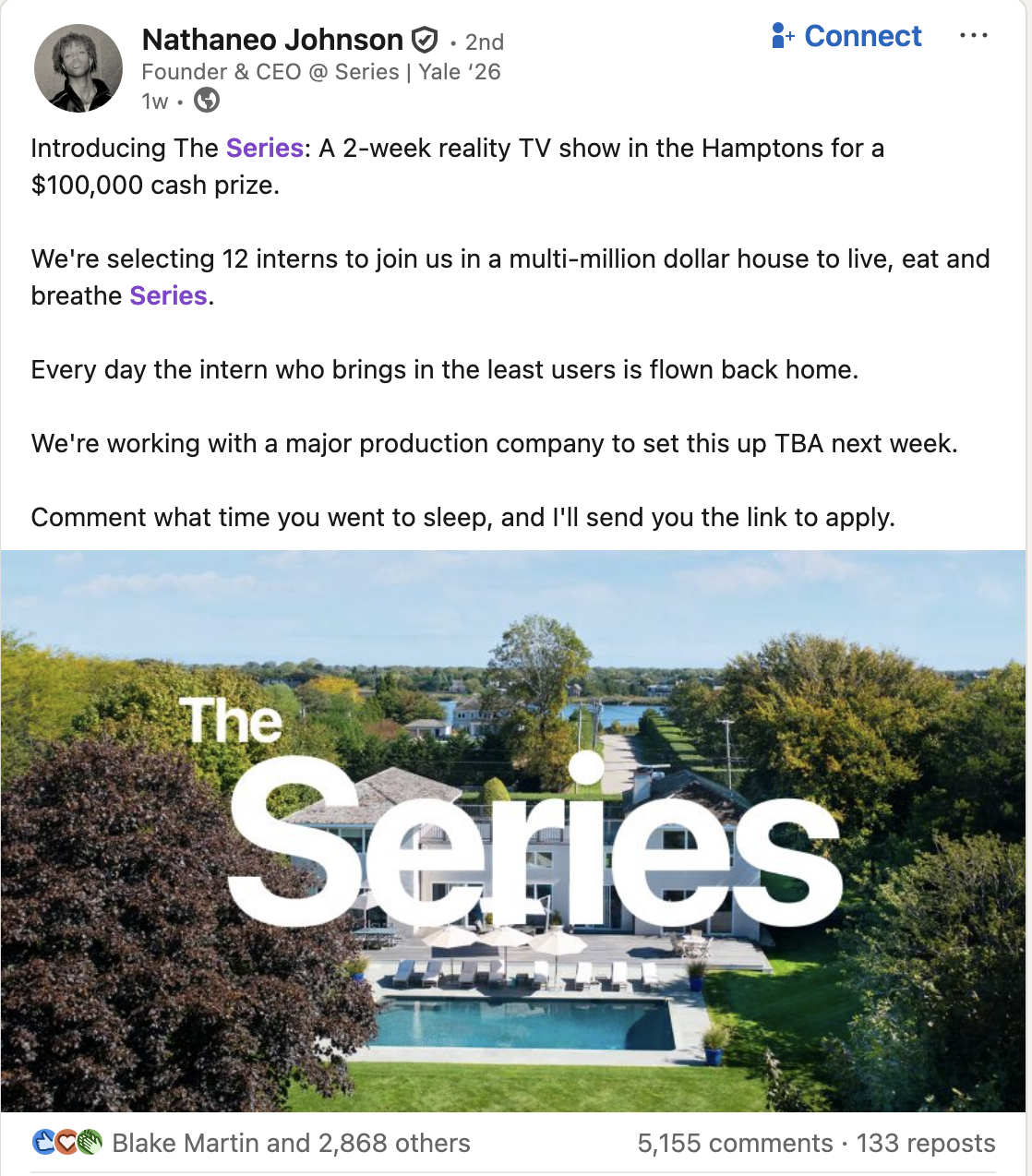
"Yeah, I knew Roy Lee—sort of"
Roy Lee's name was on my C-programming roster last fall. I'm not sure if we've ever met. Months later, I hear him on the a16z podcast talking about raising $15 million for Cluely. Here's the catch: before that, Columbia suspended him for Interview Coder, an app that captured your screen and listened to coding interview questions through your microphone, then displayed solutions in real-time through a discrete UI overlay. Think of it as having a genius programmer sitting next to you during your Google interview, except the genius was an AI that could see your coding environment and hear the interviewer's questions, then silently provide answers on your screen where only you could see them. The campus called it cheating; the internet called it interesting; investors called it opportunity.
What Is Social Capital, Really?
Before diving into Roy's story, let's define what we're actually talking about. Social capital isn't just "networking" or "having connections." It's the accumulated trust, reputation, and influence that comes from your relationships and how others perceive you. Think of it as your ability to get things done through people rather than just through your own direct efforts.
In traditional industries, social capital built slowly through decades of consistent work, mentorship, and proven results. You earned respect by shipping products, solving problems, and building relationships over time. But in tech, especially in the age of social media, social capital can be manufactured, accelerated, and weaponized in ways that previous generations couldn't imagine.
The mechanics are simple: attention converts to credibility, credibility converts to opportunity, and opportunity converts to more attention. It's a flywheel that rewards those who understand how to feed it. And once you grasp this system, you realize that technical competence alone is playing by yesterday's rules.

How Roy Spent His Social Capital
Roy's ethics? Questionable, no debate. Interview Coder punched a hole straight through hiring fairness. But Roy understood the internet's first rule: outrage travels faster than any press release. Instead of dodging the backlash, he treated every quote-tweet like free billboard space. Podcasts invited him, Twitter spaces debated him, and venture partners queued for intros.
He didn't pretend Interview Coder was an ethical hack; he doubled down. The narrative didn't soften into noble tinkering. It hardened into proof that he knew how to press the buttons that light up feeds and boardrooms alike. Cluely wasn't a redemption; it was a rebrand: cheating refocused, packaged as efficiency. And investors, trained to spot scalable tactics, didn't flinch. The same mechanics that spat answers to candidates now highlighted leads for enterprise sales.
What's fascinating is how Roy engineered his controversy cycle. Most founders panic when their first startup implodes. They pivot quietly, scrub their LinkedIn, maybe take a job at Big Tech to rebuild credibility. Roy couldn't take that route. Google, Meta, Apple all have ethics clauses and background checks that would flag Interview Coder immediately. His expulsion from Columbia made him radioactive to traditional recruiting pipelines. He was locked out of the standard redemption path that lets failed founders reset their careers with a senior engineering role.
So Roy did the opposite. He leaned into the chaos, treated every hit piece like market research, and turned his expulsion into a case study in resilience. He is forced to succeed as a founder because he can no longer succeed as anything else. When VCs looked at his pitch deck, they weren't just seeing revenue projections. They were seeing someone who could generate attention on command, who understood virality as a first-class engineering problem. More importantly, they were seeing someone with no fallback plan, someone who had to make it work because the alternative was career death.
This is the hidden dynamic that makes controversial founders so compelling to investors: they're not just hungry for success, they're trapped into success. The bridge back to safety has been burned. Big Tech won't hire them. Respectable startups won't take them. They have to build something that works, or they have nothing.
Soham Parekh: Fraud Dressed as Hustle
Soham took the same playbook and tore out the follow-through pages. He managed to land full-time engineering roles at multiple companies simultaneously, including Playground AI. The exact mechanics of how he pulled this off aren't fully public, but the results were clear: for months, each company believed they had hired a dedicated senior engineer. Meanwhile, Soham was collecting multiple Bay Area salaries while delivering roughly one-third of the expected output to each. When founders finally compared Git logs and cross-referenced his work patterns, they realized their "10x hire" was mailing in half-finished pull requests while another team waited in the lobby. Soham blamed financial pressure. Let's call it what it is: fraud.

The strangest part? Even after X exposés and Slack receipts, job offers still trickled in. It was as if his résumé (loaded with buzzwords and flashy titles) acted like immune-system blockers for due diligence. If Roy proved controversy can be refined into capital, Soham proved the market will sometimes pretend not to smell smoke if the résumé still looks shiny.
But here's what's really unsettling: Soham's con worked precisely because it exploited the systems we've built to scale talent evaluation. When you're hiring fast, you pattern-match on signals: previous companies, GitHub green squares, conference talks. The infrastructure meant to identify good engineers became the same infrastructure that let a fraudster multiply himself across multiple companies. His LinkedIn looked like every other senior engineer's LinkedIn. His code reviews sounded like every other senior engineer's code reviews. The tells were only visible when you aggregated across victims.
The Attention Economy's Technical Debt
Most engineers understand technical debt: shortcuts that speed up development but create long-term maintenance costs. Social capital operates on the same principle, but the debt compounds across entire career trajectories.
Consider the typical "thought leader" engineer: they start by sharing genuinely useful insights, maybe a clever algorithm or a war story from scaling infrastructure. The engagement is addictive. Suddenly hundreds of people are retweeting your thread about database sharding. So you tweet more. The insights get shallower, the takes get hotter, but the followers keep coming. Eventually, you're spending more time crafting the perfect thread about microservices than actually building microservices.
This isn't just vanity. It's a rational career strategy. The engineer who writes thoughtful documentation that saves their team weeks of debugging gets a "thanks" in Slack. The engineer who live-tweets their debugging process gets speaking invitations. The market has spoken: performance is harder to measure than presence.
The technical debt accumulates slowly. You start believing your own threads. You begin pattern-matching on applause rather than outcomes. Your actual engineering skills plateau because you're optimizing for different metrics. By the time you realize you're more influencer than engineer, the debt is too expensive to pay down.
Life in the Quiet Seats
When I transferred to Columbia, I carried what I believed to be impressive credentials (indie games and various side projects) but I never expected the work alone to speak for me. What I didn't anticipate was how loudly social capital would speak over everything else. I watched classmates who knew the right people get treated like VIPs. Invitations to study groups, instant trust from professors, and casual intros to industry guests while equally capable peers went unnoticed because their work lacked buzz.
I wasn't bitter, more fascinated. Like seeing the source code of campus dynamics run in real time. Warm introductions led to more warm introductions; cold emails got ignored. The equation was right there on the whiteboard, and pretending it didn't matter felt like willful blindness.
The most revealing moments happened during recruiting season. I'd watch students with identical GPAs and projects get vastly different responses from recruiters. The difference wasn't technical ability; it was narrative density. One student had "just" built a full-stack application; another had built a full-stack application, written a Medium post about it, given a talk at a local meetup, and tagged the right people when they shipped. Same code, different story distribution.
The Algorithmic Amplification Problem
Here's what makes this moment different from previous generations of tech networking: algorithms have industrialized the process of turning attention into opportunity. Social media platforms optimize for engagement, not accuracy. The most viral technical content isn't the most correct. It's the most emotionally charged, the most contrarian, the most likely to generate quote-tweets.

This creates a systematic bias toward engineers who understand content strategy as well as they understand system architecture. The quiet experts (the ones who actually built the systems everyone else analyzes) get algorithmic penalties for being measured, nuanced, boring. Meanwhile, the hot-take artists get algorithmic rewards for being provocative, simplified, engaging.
The result is a two-tier system: engineers who can code and engineers who can code and perform. The performers get the visibility, the speaking slots, the investor meetings. The non-performers get the satisfaction of actually solving problems, which turns out to be worth less than you'd think in a market that can't directly measure problem-solving ability.
The Venture Capital Feedback Loop
VCs have a measurement problem: they need to evaluate technical talent at scale, but they're not engineers themselves. So they rely on proxies: social proof, pattern matching, network effects. An engineer with 10K Twitter followers and a popular GitHub repository looks more "proven" than an engineer with neither, even if the second engineer has shipped more reliable code.
This creates a feedback loop where the most fundable engineers aren't necessarily the most competent. They're the most visible. And once you're funded, visibility becomes even more important. You need to hire, you need to raise again, you need to build partnerships. The skills that got you funded become the skills that determine your startup's success, regardless of whether they're the skills that actually build good products.
Roy Lee understood this system better than most. He knew that VCs weren't investing in Interview Coder. They were investing in someone who could generate attention reliably. The actual product was almost irrelevant. What mattered was proof of concept for his ability to create compelling narratives around technical problems.
The Long-Term Consequences
What worries me most isn't that some engineers are better at self-promotion than others (that's always been true). It's that we're creating systems where technical excellence becomes secondary to narrative excellence. Where the best engineers are the ones who can explain their work most compellingly, not the ones who do the work most effectively.
This has downstream effects on the entire industry. When social capital becomes the primary sorting mechanism for technical talent, we optimize for the wrong skills. We get founders who are great at raising money but mediocre at building products. We get senior engineers who are great at explaining architectures but shaky at designing them. We get tech leads who are great at selling ideas but inconsistent at executing them.
The irony is that the skills that make you good at accumulating social capital (narrative thinking, audience awareness, trend sensitivity) are genuinely valuable for senior technical roles. The problem is when they become the only skills that matter, when they crowd out the harder-to-measure competencies that actually determine whether software works.
The Takeaway
Social capital accelerates the competent, inflates the dubious, and renders the invisible inaudible. You don't have to celebrate Roy's pivot or excuse Soham's con to acknowledge the engine in motion. Decide how loudly you want to play, keep your receipts close, and make sure the story never outruns the work.
The system isn't going to change. If anything, it's going to get more extreme as AI makes technical differentiation harder and narrative differentiation more important. The engineers who figure out how to be genuinely excellent and genuinely visible will have enormous advantages. The ones who choose only one will be playing a losing game.
But here's the thing: you can participate in the system without being corrupted by it. You can build an audience without abandoning your principles. You can network without being transactional. You can share your work without inflating your accomplishments. The key is remembering that social capital is a tool, not a goal. Use it to amplify work that matters, not to replace work that matters.
The best engineers I know understand this balance. They share their failures alongside their successes. They give credit generously. They use their platforms to highlight others' work, not just their own. They've figured out how to be visible without being performative, how to be networked without being networked-upon.
The engineers who figure this out will build the companies that actually matter.